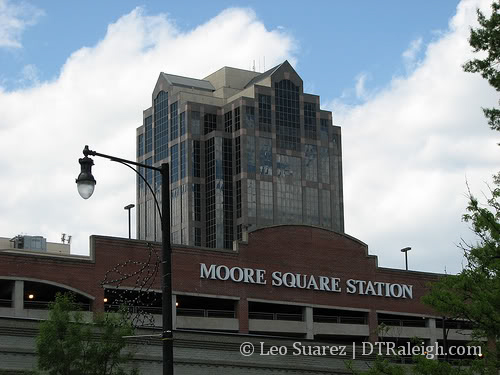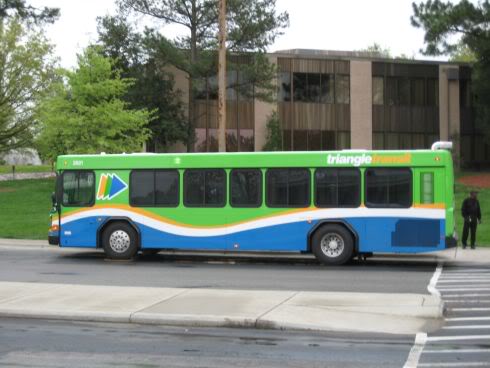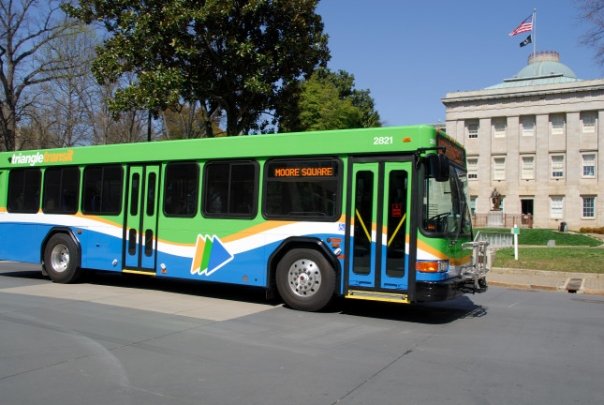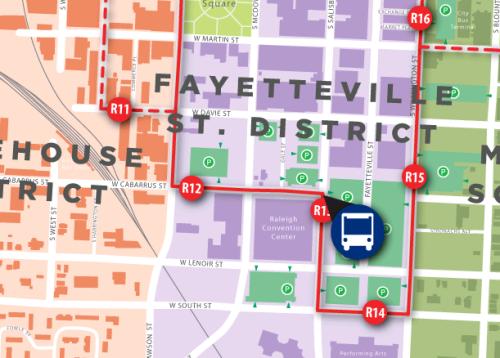The local and national media is obsessed with the topic of the current gas prices. I do not know about you, but I am overwhelmed by the amount of coverage the price of gas is getting these days. This blog 100% supports the use of other modes of transit in the triangle other then the gas powered automobile. The problem with the triangle, however, is that a reasonable alternative can be very hard to use in this ‘sprawltastic’, car-centric area we live in. However, the rise in gas prices are creating a rise in bus ridership, according to the N&O. Rather then reading about it, I decided to give Triangle Transit a try for my daily work commutes and here are my thoughts and experiences.

Moore Square is the main Raleigh hub for most bus routes
Researching The Route
I live in downtown and work in RTP so I needed to find the bus route to get me out there and back. As an internet junkie, my first path to finding information is almost always the internet so naturally, I went to Triangle Transit’s website for information. The trip planner is horrible and it did not get my route to appear after a couple tries. Maybe you have more patience then I do but I decided to skip this tool and move on to the list of maps and schedules. This was easier for me to find what I needed and “Route 105: RTP to NCSU to Raleigh” was the one I needed to ride. After that, there was an RTP bus circulator that went from the RTP transfer station up to my place of work.
The website offers a simple text schedule, the route brochure as a .pdf file, and a Google map of the route with major and minor stops pinpointed along the way. This is good information for those that want to plan their way. After doing the website research and printing out some documentation, I was all set to ride.
Cost
At the start of this new transit experiment, I bought bus tickets and filled my car’s tank completely. The idea was to see how long I could go without paying any more money towards transit. A transit cost for this experiment is gas or a bus ticket and at the start I paid about $95.
A pack of 12 Triangle Transit tickets costs $41 and one ticket will give you unlimited rides per day. That comes out to $3.42 per day if you ride the bus. At the time of this particular visit to the gas station, the cost of regular gasoline was $3.53 a gallon. Assuming my car’s 32 mpg rating on the highway and a DTR/RTP distance of 18 miles (36 both ways), it costs about $3.97 to drive my car to work.
The Ride – Positives
Probably one of the best points of riding the bus is that someone else is doing the driving for you. While riding, you have the time to sleep, read, blog, play games or do anything because you do not have to deal with traffic yourself. I used this time to read more and would watch video podcasts on my ipod, where I could not before because I was paying attention to the road. When someone else is driving, you can focus more attention on another activity and perhaps get work done during your commute. This could be really beneficial to those who love to multi-task.
Cost was another great benefit to riding. Referring back to my numbers above, it is clear that riding the bus is the more cost effective choice. The bus fares are not rising and have been the same throughout this whole gas price hike. The price of gas is much higher then $3.53 today so the cost benefit of riding the bus is only strengthening. I went a full four weeks without paying for another transit cost.
While riding, my car was just sitting around doing nothing. This is great because no gas is being used, no stress or miles is being put on the car, and there is now one less car on I-40 during rush hour traffic. I’m a little bit of an Ecogeek too, so the added fact that I’m not pouring emissions into the air is a bonus.

Triangle Transit’s sleek new look
Negatives
Time is the biggest negative to this new transit venture. Driving to work on average throughout this experiment would take 25 minutes in the morning and 40 minutes in the evening. Riding the bus was almost three times longer, with rides averaging 1 hour and 15 minutes in the morning and 1 hour and 40 minutes in the evening. This makes a huge difference for someone that is busy and fitting in these huge blocks of time into my schedule was a real hassle. The afternoon ride times were more inconsistent then the morning rides. Even though I was not dealing with traffic, the bus was and heavy traffic on I-40 sometimes pushed my ride home past the two hour mark. If I was driving, I could avoid certain traffic zones where the bus must stay on its route.
During this experience, I learned to tolerate Triangle Transit rather then trust it. The buses were generally not on time, plain and simple. For those interested in catching a bus mid-route, I would recommend showing up 10 minutes before the posted time. If early, buses would stop but would not wait until the posted time to continue the route. There were a few cases of clear driver negligence where requested bus stops were passed. The RTP circulator also needs a makeover. My particular route would go one way in the morning and a completely new one in the afternoon. It may not bother you but I see another layer of confusion in this, more so because it does not at all follow the posted schedule on the Triangle Transit website.
The Verdict
We all have our own opinions. We all live and work in different areas so your particular experience will be different from mine. With that and the experience I just shared I have decided not to continue riding the bus as the time factor is the real kicker for me. The bus is just too slow and it is not worth it to me to ride it for so long. Right now, the gas prices have not been applying enough pressure for me to be a full on committed rider; I have found other ways to save money. Even though I do not ride, I encourage everyone to give Triangle Transit or the other bus services a try. If you have never ridden, it is a completely different experience then you think. Again, RalCon fully supports other means of transit in Raleigh other then cars and I hope one day (in my lifetime) we’ll see a network of trains, streetcars, and buses that can serve everyone. For now, I’ll stick to practicing EcoModder’s 105 Hypermiling and Ecodriving tips.




